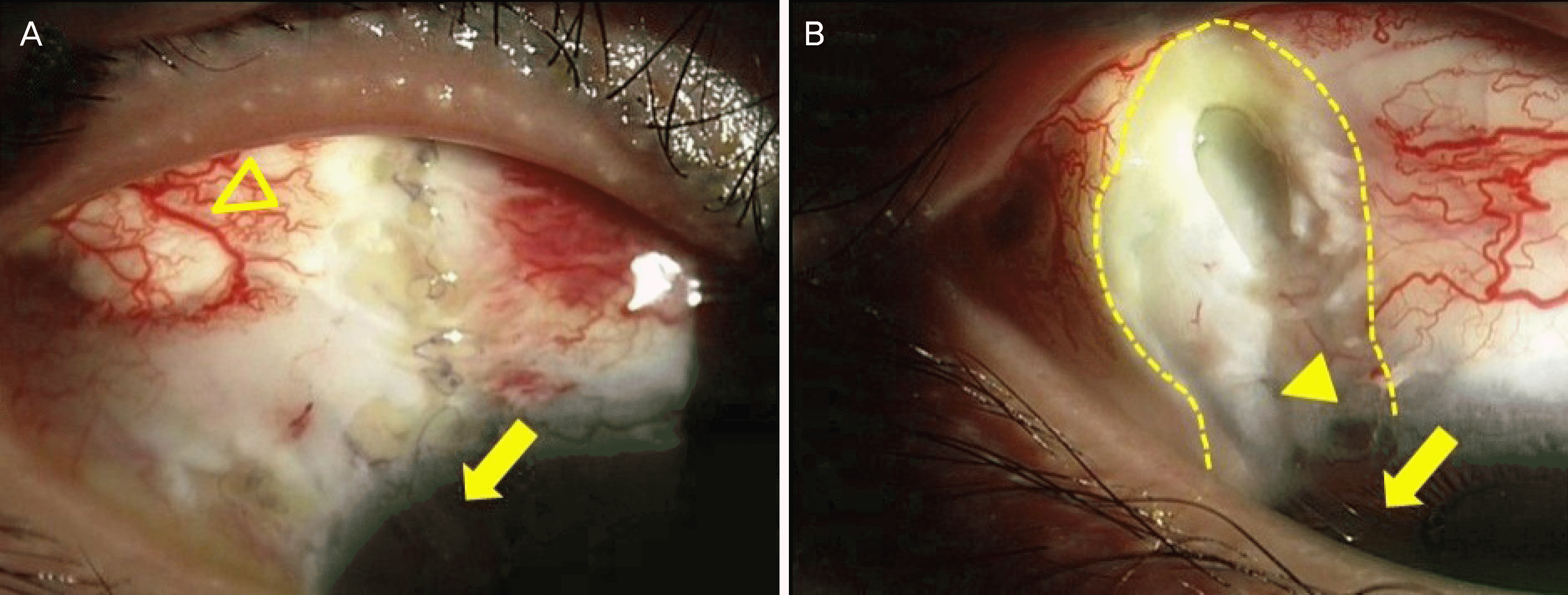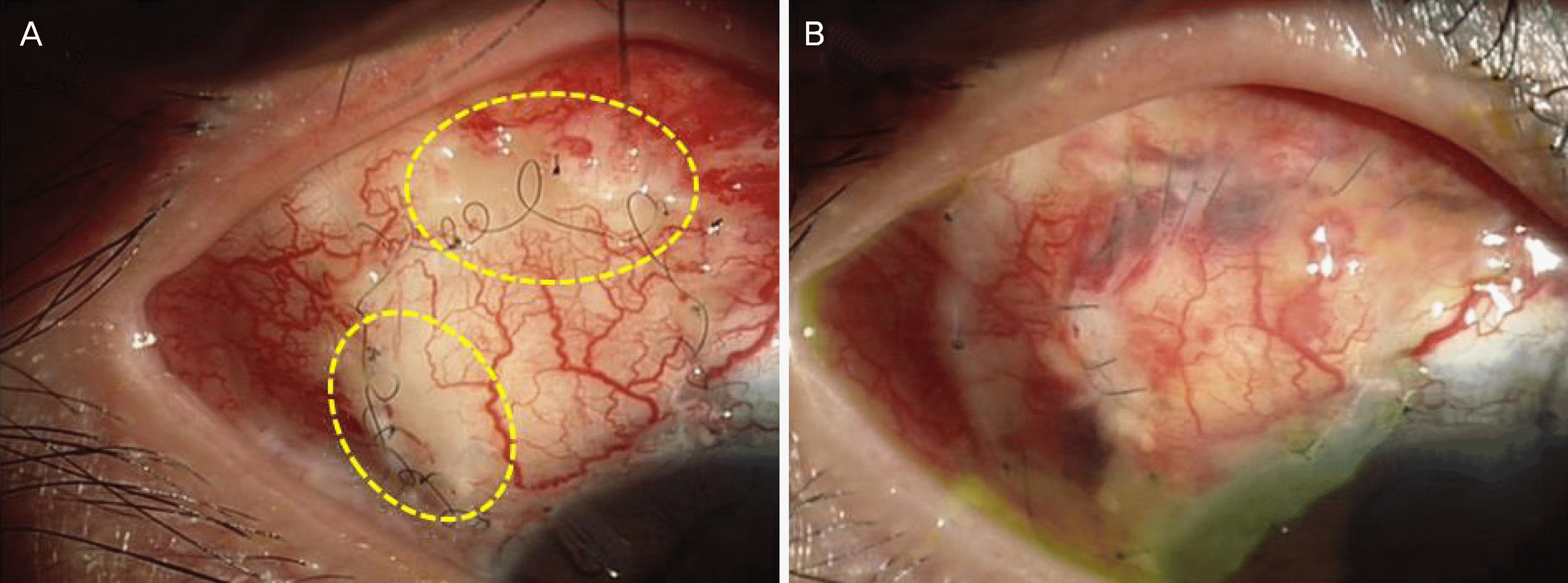Abstract
Purpose
We report a case of conjunctival necrosis in a glaucoma patient who underwent Ahmed valve implantation and subtenon triamcinolone injection.
Case summary
A 22-year-old female was referred to our clinic for uncontrolled intraocular pressure despite trabeculectomy and repeated subconjunctival injections of mitomycin C in her right eye. Ahmed valve implantation and subtenon triamcinolone injection were performed in the right eye. Four weeks later, conjunctival necrosis was observed. After debridement of necrotic tissue, an additional conjunctival autograft was needed because of recurrence of the conjunctival necrosis. After amniotic membrane transplantation was performed for one more recurrent conjunctival necrosis, conjunctival epithelialization was completed.
Conclusions
Although conjunctival necrosis after periocular injection of triamcinolone is a rare complication, previous multiple usage of antimetabolites such as mitomycin C might be associated with a higher risk of developing conjunctival necrosis. In such cases, aggressive surgical intervention may be helpful in the reconstruction of the conjunctival epithelium.
References
1. Athanasiadis Y, Tsatsos M, Sharma A, Hossain P. Subconjunctival triamcinolone acetonide in the management of ocular abdominal disease. J Ocul Pharmacol Ther. 2013; 29:516–22.
2. Corbett MC, Hingorani M, Boulton JE, Shilling JS. Subconjunctival betamethasone is of benefit after cataract surgery. Eye (Lond). 1993; 7(Pt 6):744–8.

4. Helm CJ, Holland GN. The effects of posterior subtenon injection of triamcinolone acetonide in patients with intermediate uveitis. Am J Ophthalmol. 1995; 120:55–64.

5. Hwang HB, Park YH. The effect of posterior subtenon abdominal injection in panretinal photocoagulation induced abdominal dysfunction of diabetic retinopathy. J Korean Ophthalmol Soc. 2009; 50:864–9.
6. Eslampour A, Abrishami M, Tafaghodi S. Conjunctival necrosis and scleritis following subtenon triamcinolone acetonide injection. Iran Red Crescent Med J. 2013; 15:614–6.

7. Chong YJ, Wong CK, Ismail S. Conjunctival necrosis following a subconjunctival injection of triamcinolone acetonide in a child. Middle East Afr J Ophthalmol. 2015; 22:125.

8. van Zyl LM, Hill JJ. Conjunctival necrosis due to subconjunctival methylprednisolone (Depo-Medrol [TM]) acetate injection. Middle East Afr J Ophthalmol. 2010; 17:385–6.
9. Yaldiz H. Conjunctival necrosis due to subconjunctival depot abdominal injection. Turk J Ophthalmol. 2010; 40:248–9.
10. Kim T, Rpuano CJ, Rodman RC, et al. Conjunctival necrosis abdominal the administration of subconjunctival corticosteroid. Ophthalmic surg lasers. 1998; 29:79–80.
11. Zamir E, Pe'er J. Necrotizing conjunctival ulceration following subconjunctival depot methylprednisolone injection. Ophthalmic Surg Lasers. 1999; 30:565–6.

12. Fogla R, Rao SK, Biswas J. Avoiding conjunctival necrosis after periocular depot corticosteroid injection. J Cataract Refract Surg. 2000; 26:163–4.

13. Allen QB, Lowder CY, Medisler DM. Conjunctival necrosis abdominal the administration of subconjunctival corticosteroid. Ophthalmic Surg Lasers. 1998; 29:779–80.
14. Moshfeghi DM, Kaiser PK, Scott IU, et al. Acute endophthalmitis following intravitreal triamcinolone acetonide injection. Am J Opthalmol. 2003; 136:791–96.

15. Agrawal S, Agrawal J, Agrawal TP. Conjunctival ulceration abdominal triamcinolone injection. Am J Ophthalmol. 2003; 136:539–40.
16. Güngor IU, Beden U, Erkan D. Conjunctival necrosis due to abdominal injection of betametasone in treatment of graft abdominal after penetrating keratoplasty. Ophthalmic Surg Lasers Imaging. 2005; 36:348–9.
17. Srinivasan S, Prasad S. Conjunctival necrosis following intravitreal injection of triamcinolone acetonide. Cornea. 2005; 24:1027–8.

18. Hsu WC, Spilker MH, Yannas IV, Rubin PA. Inhibition of abdominal scarring and contraction by a porous collagen-abdominal implant. Invest Ophthalmol Vis Sci. 2000; 41:2404–11.
19. Park KS, Kim KN, Lee SB, et al. Comparison of the effects and complications between conventional trabeculectomy and abdominal with collagen matrix insertion. J Korean Ophthalmol Soc. 2018; 59:50–9.
20. Cillino S, Casuccio A, Di Pace F, et al. Biodegradable collagen abdominal implant versus mitomycin-C in trabeculectomy: five-year fol-low-up. BMC Ophthalmol. 2016; 16:24.

21. Akle CA, Adinolfi M, Welsh KI. Immunogenicity of human abdominal epithelial cells after transplantation into volunteers. Lancet. 1981; 2:1003–5.
22. Gris O, Del campo Z, Wolley-Dod C, et al. Conjunctival healing abdominal amniotic membrane graft over ischemic sclera. Cornea. 2003; 22:675–8.
23. Bergstrom TJ, Wilkinson WS, Skuta GL, et al. The effects of abdominal mitomycin-C on glaucoma filteration surgery in rabbits. Arch Ophthalmol. 1991; 109:1725–30.
24. Palmer SS. Mitomycin as adjunct chemotherapy with trabeculectomy. Ophthalmology. 1991; 98:317–21.

25. Yu YS, Youn DH. The effect of colchicine on fibroblast abdominal after glaucoma filtering surgery. Korean J Ophthalmol. 1987; 1:59–71.
26. Jongsareejit B, Tomidokoro A, Mimura T, et al. Efficacy and complications after trabeculectomy with mitomycin C in abdominal-tension glaucoma. Jpn J Ophthalmol. 2005; 49:223–7.
27. Shin IH, Hyung SM. Outcome of fornix-based versus lim-bus-based conjunctival flaps in trabeculectomy with mitomycin C. Korean J Ophthalmol. 2003; 44:2829–37.
28. Woo KJ, Hyung S. Effect of needle revision of failed filtering blebs with different concentrations of mitomycin C. J Korean Ophthalmol Soc. 2008; 49:951–7.

Figure 1.
Anterior segment photography after Ahmed valve implantation with subtenon triamcinolone injection. (A) Conjunctival necrosis 4 weeks later. (B) Recurred and widened conjunctival necrosis 12 weeks later. The arrow denotes the tube of the Ahmed glaucoma drainage device inserted in the anterior chamber. The blank arrowhead denotes triamcinolone injected with Ahmed valve implantation. The arrowhead denotes the exposed margin of the half thickness scleral flap covering the tube of the Ahmed glaucoma drainage device. The dashed line denotes the boundary of the conjunctival necrosis.

Figure 2.
Anterior segment photography after Ologen® insertion and placing a conjunctival autograft and an amniotic membrane patch. (A) The dashed line denotes the boundary of the Ologen®, and the arrow denotes the suture site of the conjunctival autograft 1 day later. (B) Fluorescein dye was applied. The continuous line denotes the boundary of the amniotic membrane patch 1 day later. (C) The amniotic membrane patch dropped. The conjunctival autograft was recovering 1 week later.

Figure 3.
Anterior segment photography 2 weeks after Ologen® insertion and placing a conjunctival autograft and an amniotic membrane patch. (A) The two dashed ellipsoids denote the recurred conjunctival necrosis. (B) Debridement, amniotic membrane implantation, conjunctival suture, and amniotic membrane patch graft were sequentially conducted.





 PDF
PDF ePub
ePub Citation
Citation Print
Print



 XML Download
XML Download